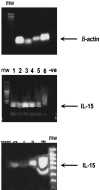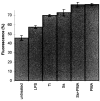Production and distribution of interleukin 15 and its receptors (IL-15Ralpha and IL-R2beta) in the implant interface tissues obtained during revision of failed total joint replacement
- PMID: 11488993
- PMCID: PMC2517707
- DOI: 10.1046/j.1365-2613.2001.iep0082-0201-x
Production and distribution of interleukin 15 and its receptors (IL-15Ralpha and IL-R2beta) in the implant interface tissues obtained during revision of failed total joint replacement
Abstract
Failure of total joint replacement (TJR) is a major problem and it is estimated that 15-20% of TJR will fail within 5-10 years after implantation. Most TJR is attributed to aseptic loosening of the implants in association with resorption of related bone due to the release of bone-associated cytokines. IL-15 is a cytokine that activates T cells and natural killer (NK) cells. IL-15 protein is ubiquitous and is expressed in many tissues and cell types. Using immunohistochemical techniques, we demonstrated the expression of IL-15 and its receptors IL-15Ralpha and IL-2Rbeta in the interface tissues obtained from revision surgery. Both IL-15 protein and IL-15Ralpha were observed in macrophages, multinucleated giant cells and endothelial cells around blood vessels. Both the SDS-PAGE and western blot revealed multiple bands and after stages of glycosylation, this resulted in a band at 13 KDa which corresponds to the IL-15 protein. Again RT-PCR results demonstrated a band of 420 bp corresponding to the IL-15 protein. In addition, using U937 cells, the expression of both IL-15 protein and IL-15Ralpha were considerably up-regulated when challenged with retrieved metal particles. Our results illustrated the IL-15 to be an intact protein and that it is stored in the cytoplasm. A dye exclusion cell viability test displayed an increase in toxicity with an increase in the amount of metal particles added. There was a discrepancy between abundant IL-15 mRNA, intracellularly detectable IL-15 protein and apparently inefficient secretion. This suggests that IL-15 protein production is predominantly regulated post-transcriptionally and this is indicated by its strict regulation, especially at cell trafficking. Finally, unlike IL-2, IL-15 plays a certain role in bone resorption that leads to failed joint prostheses. It is apparent that this cytokine is an important T cell mediated immune response which needs further research.
Figures












Similar articles
-
Natural splicing of exon 2 of human interleukin-15 receptor alpha-chain mRNA results in a shortened form with a distinct pattern of expression.J Biol Chem. 1999 Sep 17;274(38):26978-84. doi: 10.1074/jbc.274.38.26978. J Biol Chem. 1999. PMID: 10480910
-
Coordinate expression and trans presentation of interleukin (IL)-15Ralpha and IL-15 supports natural killer cell and memory CD8+ T cell homeostasis.J Exp Med. 2004 Oct 4;200(7):825-34. doi: 10.1084/jem.20041389. Epub 2004 Sep 27. J Exp Med. 2004. PMID: 15452177 Free PMC article.
-
Synthesis and secretion of interleukin-15 by freshly isolated human bronchial epithelial cells.Int Arch Allergy Immunol. 2004 Nov;135(3):235-42. doi: 10.1159/000081309. Epub 2004 Oct 4. Int Arch Allergy Immunol. 2004. PMID: 15467375
-
IL-15 and IL-15Ralpha in CD4+T cell immunity.Arch Immunol Ther Exp (Warsz). 2005 Mar-Apr;53(2):115-26. Arch Immunol Ther Exp (Warsz). 2005. PMID: 15928580 Review.
-
The interleukin-15/interleukin-15 receptor system as a model for juxtacrine and reverse signaling.Bioessays. 2006 Apr;28(4):362-77. doi: 10.1002/bies.20380. Bioessays. 2006. PMID: 16547946 Review.
Cited by
-
The combined role of wear particles, macrophages and lymphocytes in the loosening of total joint prostheses.J R Soc Interface. 2008 Nov 6;5(28):1263-78. doi: 10.1098/rsif.2008.0142. J R Soc Interface. 2008. PMID: 18647740 Free PMC article. Review.
-
Functional roles of cytokines in infectious disease associated colorectal carcinogenesis.Mol Biol Rep. 2022 Feb;49(2):1529-1535. doi: 10.1007/s11033-021-07006-4. Epub 2022 Jan 4. Mol Biol Rep. 2022. PMID: 34981335 Review.
-
TLR-9 and IL-15 Synergy Promotes the In Vitro Clonal Expansion of Chronic Lymphocytic Leukemia B Cells.J Immunol. 2015 Aug 1;195(3):901-23. doi: 10.4049/jimmunol.1403189. Epub 2015 Jul 1. J Immunol. 2015. PMID: 26136429 Free PMC article.
-
Expression profile of T cell associated molecules in the interfacial tissue of aseptically loosened prosthetic joints.J Mater Sci Mater Med. 2002 Dec;13(12):1153-6. doi: 10.1023/a:1021137921463. J Mater Sci Mater Med. 2002. PMID: 15348658
-
Periprosthetic osteolysis: characterizing the innate immune response to titanium wear-particles.J Orthop Res. 2010 Nov;28(11):1418-24. doi: 10.1002/jor.21149. J Orthop Res. 2010. PMID: 20872576 Free PMC article.
References
-
- Bainbridge J, Dalby M, Curtis P, Knight M, Revell P. Cytoskeletal changes in macrophages and gaint cells following exposure to wear debris. 2000 Abstract submitted to the UK Society for Biometrials.
-
- Balknill F. Oxford: IRL Press; 1996. Cytokine: A practical approach.
-
- Bamford RN, Defilippis AP, Azimi N, Kurys G, Waldmann TA. The 5′ untranslated region, signal peptide and coding sequence of the carboxyl terminus of IL-15 participate in its multifaceted translational control. J. Immunol. 1998;160:4418–4426. - PubMed
-
- Daffada AAL, Murray EJ, Young SP. Control of activator protein 1 and nuclear factor Kappa β activity by international interleukin-6 and metals in HEPG2 cells. Biochim. Biophys. Acta. 1994;1222:234–240. - PubMed
-
- Doherty TM, Seder RA, Sher A. Induction and regulation of IL-15 expression in murine macrophages. J. Immunol. 1996;156:735–741. - PubMed
Publication types
MeSH terms
Substances
LinkOut - more resources
Full Text Sources
Other Literature Sources
Medical

